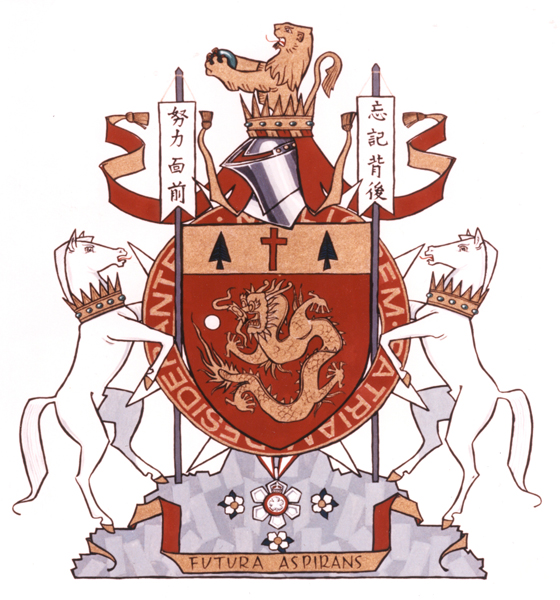
Canada

Registered in The Chinese Armorial, October 25, 2011.
Arms: Gules a Chinese dragon Or reaching for a pearl Argent on a chief Or a Latin cross Gules between two pine trees Vert.
Crest: Above a helmet mantled Gules doubled Or on a wreath Or and Gules an Antique Crown Or garnished with jade proper issuant therefrom a demi lion Or holding between his forepaws a jade ball proper
Supporters: to be borne and used during his lifetime: On a rocky promontory proper charged with three Pacific Dogwood flowers Argent leaved Vert seeded Or two horses Argent langued Gules unguled Or gorged with
Antique crown Or garnished with jade proper each horse holding a gonfalon Argent the dexter one inscribed ![]() and the sinister one inscribed
and the sinister one inscribed ![]() in letters Sable.
in letters Sable.
Motto: FUTURA ASPIRANS
Grant: Canadian Heraldic Authority, The Public Register of Arms, Flags and Badges of Canada, Volume I, page 26, August 28, 1989.
Background and History:
Dr. David See-Chai Lam, the first Chinese Canadian to be appointed Lieutenant Governor of a Canadian province and to hold a vice-regal position in Canada, was also the first Chinese Canadian to receive a grant of arms from the Canadian Heraldic Authority.
The shield's main charge is a Chinese dragon, the animal of Imperial China, to symbolize his being a Chinese Canadian representing the Queen of Canada. As in many illustrations of Chinese dragons, it is chasing a pearl or sun. The number of claws per paw on the dragon is not specified in the blazon, but the Letters Patent issued by the Canadian Heraldic Authority depicts a five-clawed dragon to show Lam represents the Queen.
The coat of arms has the following symbols of British Columbia: the Pacific Dogwood flowers (the provincial flower), the two pine trees, and the rocky mountain on which the two horses stand. The trees also symbolize Dr. Lam’s name, which means “forest” in Chinese.
The colours red and gold, the dragon, and the banners are from Chinese tradition. Red and gold also served as vice-regal colours in the Ming and Ching Dynasties.
The antique crown, seen around the horses’ necks and in the crest, is a Western heraldic symbol of service in the Near or Far East. The antique crown is sometimes called the eastern crown. It also appears in the chief of the coat of arms of British Columbia. In Dr. Lam’s arms, the antique crowns are garnished with jade, a stone greatly prized in China and found in rivers in central British Columbia.
The crest, a lion holding the jade ball, alludes to Dr. Lam’s birthplace, Hong Kong. The crest is based on the crest of the arms of the Colony of Hong Kong, a lion holding a pearl.
The supporters are horses, symbols of strength and power.
The cross is a symbol of Mr. Lam’s Christian faith. The Chinese messages on the two banners are “Forgetting the past” (sinister banner) and “Reaching forward to the future” (dexter banner). The message is from the Bible’s New Testament, the Book of Philippians, chapter 3, verse 13.
The motto “Futura Aspirans” is Latin for “future aspirations,” which is the closest Latin rendition of the Chinese message on the banners.
The shield is shown encircled by the motto ribbon of the Order of Canada and with the decoration of an Officer of the Order of Canada suspended from the shield, as David Lam was an Officer of the Order of Canada. The Maltese cross of the Most Venerable Order of the Hospital of St. John of Jerusalem is placed behind the shield because the Hon. David Lam was a Knight of the Order.
Dr. Lam, as a current and former Lieutenant Governor, was entitled to use the supporters and the motto ribbon of the Order of Canada on his coat of arms for life. The supporters and Order of Canada motto ribbon are not hereditary; however, his descendants can inherit the coat of arms and crest.
David Lam passed away on November 22, 2010.
* deceased.